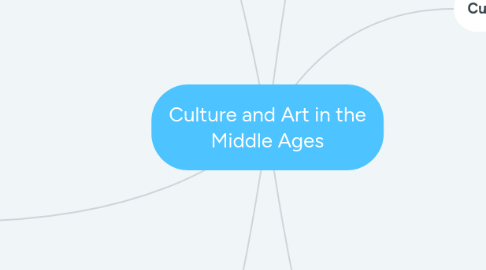
1. The Cultural wealth of the Iberian Peninsula
1.1. European trends on Iberian Peninsula
1.1.1. Centuries of Early Middle Ages on Iberian Peninsula marked by Andalusian hegemony.
1.1.2. European influences in Christian Kingdoms
1.1.2.1. Arrival of Order of Cluny
1.1.2.2. Marriages of royal families from France and England.
1.1.2.3. Pilgrimages to Compostela.
1.1.3. Monasteries in Christian Kingdoms
1.1.3.1. Until 13th century the culture of the Christian Kingdoms was in hands of the Church
1.1.3.1.1. Beatus Manuscripts
1.1.4. Contact between the three cultures
1.1.4.1. Taifa period don't mean a control of Andalusian cultural activity
1.1.4.1.1. Jewish developed Islamic territories
1.1.5. Alfonso X El Sabio
1.1.5.1. Alfonso X was removed for his work in politics and culture which earned him the title ''The Wise''
1.1.6. Culture in Late Middle Ages
1.1.6.1. Was based in Universities and Literature
2. Romanesque art
2.1. Was developed in western Europe during 11th and 12th centuries.
2.2. Architecture
2.2.1. Churches were formed in a form of Latin Cross.
2.2.2. Naves were separated by pillars
2.2.3. Roof formed by a barrel vault
2.2.4. There was a semi-circular area in the end of church.
2.2.5. Walls were very thick and were made of ashlars.
2.3. Sculpture and Painting
2.3.1. Sculpture
2.3.1.1. Portals were mainly carved with images of Christ
2.3.1.2. Capital were carved with demons and eastern-inspired fantastic beasts
2.3.1.3. Wooden carvings were also made mainly of Christ on the cross of the Virgin.
2.3.2. Painting
2.3.2.1. Was mainly done in Fresco to decorate the interior of church walls. The mainly themes were the Virgin with the child and the Pantocrator.
3. Gothic Art
3.1. Architecture
3.1.1. Cathedrals were built in grand proportions and located in cities with episcopal see
3.1.2. Another element were the gargoyles, than are sculptural adornments that depict monsters and fantastic beasts
3.2. Sculpture and painting
3.2.1. The gothic sculpture differed in some key respects from Romanesque sculpture. And gradually became independent Architectural framework.
3.2.2. Painting became less strictly dependent on the style of architecture. This is because when large windows were opened ot was no longer necesary to decorate them with frescoes.
4. Religion
4.1. Medieval culture was deeply religious. The literature, philosophy and arts of period reflect a theocentric mentality.
4.1.1. Secular Clergy
4.1.1.1. Basic Managament done by the priests
4.1.1.2. Above them were high clergy the bishops managed diocese.
4.1.2. Regular Clergy
4.1.2.1. Monastic Orders
4.1.2.1.1. Order of Cluny
4.1.2.1.2. Cistercian Order
4.1.2.2. Mendicant Orders
4.1.2.2.1. Franciscans
4.1.2.2.2. Dominicans
4.2. Expressions of Religion
4.2.1. Pilgrimages in the Middle Ages
4.2.2. Popular Religiosity
4.3. Crusades
4.3.1. The Holy land is where Jesus Christ preach and die which was in hands of islam. Crusades were inspired by the popes.
5. Culture in Medieval Europe
5.1. Monasteries
5.1.1. Culture shut away in monasteries. Work of monks took place in monasteries. Although Greco-Roman culture was not completely rejected, was compatible with Christian Doctrine was accepted.
5.2. Universities
5.2.1. Cultural Activities moved to the cities. Thanks to bishops schools associated with the local cathedral were founded. First universities or studia generalia emerged from schools in 13th century.
5.3. Literature in Romance languages
5.3.1. Latin evolved in Romance Languages: French, Portuguese, Castilian, Catalan, etc.
5.3.1.1. Chansons de Geste
5.3.1.1.1. Form of literally expression in songs.
5.3.1.2. Courtly Poetry
5.3.1.2.1. Form of literally expression in poems
5.4. Advancement of Secular Culture
5.4.1. During High and Late Middle Ages, commercial and urban growth a strong increase in number of intellectuals who were not clergymen.
5.4.1.1. In 14th century were many conflicts, was marked by a strongly pessimistic way of thinking and obsession with death.
5.4.1.1.1. And in Italian Cities were precursors of Humanism with poets such as Dante, Bocaccio and Petrarch emerging.
6. Medieval Art on the Iberian Peninsula
6.1. Art in Al-Andalus
6.1.1. Taifa Period
6.1.1.1. Andalusian art characterised by construction of civil buildings.
6.1.2. Almohad Art
6.1.2.1. Buildings from this period stand out for their use of brick.
6.1.3. Nasrid Art
6.1.3.1. Was developed in the Kingdom of Granada. And the finest exapmble was the Alhambra Palace.
6.2. Mudéjar art
6.2.1. The fusion of the cultures can be reflexed in Mudéjar art some focal points of Mudéjar Art were
6.2.1.1. Andalusia: Alcázar of Sevilla
6.2.1.2. Aragón: Cathedrals of Zaragoza, Tarazona and Teruel.
6.2.1.3. Castilla y León: Churches in Sahagún and Cuéllar
6.3. Romanesque Art
6.3.1. Romanesque art was at its height in 11th and 12th centuries.
6.3.1.1. Architecture
6.3.1.1.1. Many churches were built in 12th century. Including the church of San Millán de Duero in Soria.
6.3.1.2. Sculpture
6.3.1.2.1. Notable works of sculpture were capital like those of monastery of San Juan de la Peña.
6.3.1.3. Painting
6.3.1.3.1. The interior of Romanesque churches were decorated with Freco Paintings.
6.4. Gothic Art
6.4.1. Architecture
6.4.1.1. The most specific to Gothic Architecture were introduced during the construction of the cathedrals of Cuenca and Ávila.
6.4.1.1.1. The cathedrals were influence of French Gothic
6.4.2. Sculpture
6.4.2.1. Was characterised by stylisation of forms and naturalist representation of Humans figures.
6.4.3. Painting
6.4.3.1. Substituted Romanesque frescoes with stained glass windows.

